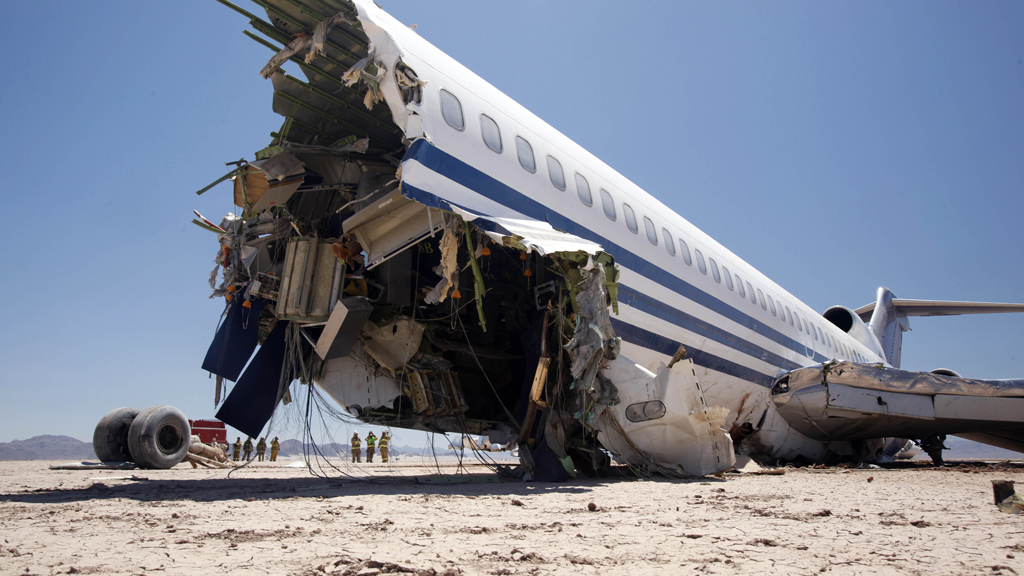‘Once in a generation’ plane crash study
A dramatic new Channel 4 documentary follows an international team of experts in real time to provide a once in a generation study of a specially recreated plane crash.

The documentary follows a team of scientists, experts and elite pilots as they deliberately crash land a 170-seat Boeing 727 passenger jet to provide a once-in-a-generation chance to study the mechanics of a plane crash in real time.
The documentary recreates a common type of crash – a serious, but survivable, ‘forced landing’ – in order to study the crashworthiness of the aircraft’s airframe and cabin, examine the impact of crashes on the human body and look for possible means of increasing passenger survivability.
By crashing the plane, the programme also aims to answer key questions, such as whether sitting at the front or the rear of the aircraft, wearing a seat belt and whether you use the brace position can make the difference between life and death.
What happens when a plane crashes? View a stills gallery
Fed Ex Captain James ‘JimBob’ Slocum, who has previously survived three plane crashes, pilots the passenger jet, nick-named ‘Big Flo’ (after crew member Leland ‘Chip’ Shanle’s grandmother, Florence) on her last flight.
Rather than carrying passengers, the plane was packed with state of the art research equipment, including three crash test dummies worth $150,000 each (plus a number of simpler sand bag dummies) and accelerometers to measure the G forces on passengers. Dozens of cameras recorded the crash from inside the aircraft, on the ground, in chase planes and even on the pilot’s helmet.
Unique experience
The scientific team behind the project included John Hansman, Professor of Aeronautics at MIT; Anne Evans, a former senior air crash investigators at the Air Accidents Investigation Branch; Dr Cynthia Bir, a Bio-mechanist at Wayne State University and Dr Tom Barth, an accident investigator and biomechanics engineer.
Anne Evans helped to piece together what happened at Lockerbie, Kegworth and dozens of other aircraft disasters worldwide. But despite years of studying crash sites, she had never seen a plane crash with her own eyes.
“This is a unique experience to be able to see the aircraft beforehand and watch it crash,” she said. “We wanted something that’s survivable. It’s had to be a bit heavier than a normal landing, but not so heavy that the aircraft’s destroyed and we lost everything.”
Plane crashes are rare, and flying is safer than ever before, but many people still fear it. Despite extensive testing, no manufacturer has ever tested one of their planes in this way before.
“We crash cars all the time, we don’t do that with planes to see if we can make them safer, which is what makes this such a unique opportunity,” said Dr Cynthia Bir.
Every crash is different, but based on the results of the experiment, some of the scientists’ conclusions about this crash were as follows:
• The passengers in the front few rows of the plane would almost certainly not have survived the crash and the crew would most likely have been killed too.
• Passengers in the centre of the plane would have survived with minor injuries. Passengers at the rear would have been mostly unharmed.
• Impact forces at the front of the plane peaked at 12 G (12 times the force of gravity), in the centre the force was less, 8 G, at the rear it was 6 G, half that at the front and no greater than being hit in a fairground bumper car.
• The under-wing landing gear of the plane snapped off, as they should, so that they don’t rupture the fuel tanks in the wings and cause an explosion. The wings stayed attached and the mainframe of the aircraft remained largely intact.
• The nose landing gear remained attached, as designed, but this led to the nose breaking off. Could introducing landing gear that snaps off have saved the life of the flight crew and those sitting at the front of the plane?
• Passengers not wearing seat belts would have ‘submarined’ under the seat in front, potentially leading to serious injuries.
• The dummy in an unbraced position would have sustained potentially serious head injuries as their head accelerated forwards rapidly.
• The head of the dummy in the braced position moved only a few inches. However, the position meant that the body weight was forced onto the lower legs, possibly leading to injury and difficulty walking off the plane.
• The overhead lockers remained intact, but there was debris in the cabin which could have injured passengers and overhead ceiling panels and wiring collapsed, which could have impeded passengers’ ability to get off the aircraft.
The Plane Crash will be shown on 11 October at 9pm.
-
Latest news
-
Laughing Boy: New play tells the tragic tale of Connor Sparrowhawk5m

-
Sewage warning system allows some of worst test results to be left off rating system, analysis shows3m

-
Post Office inquiry: Former CEO didn’t like word “bugs” to refer to faulty IT system4m

-
Israeli soldier speaks out on war in Gaza12m

-
PM’s defence spending boost should be ‘celebrated’, says former Armed Forces Minister4m

-




